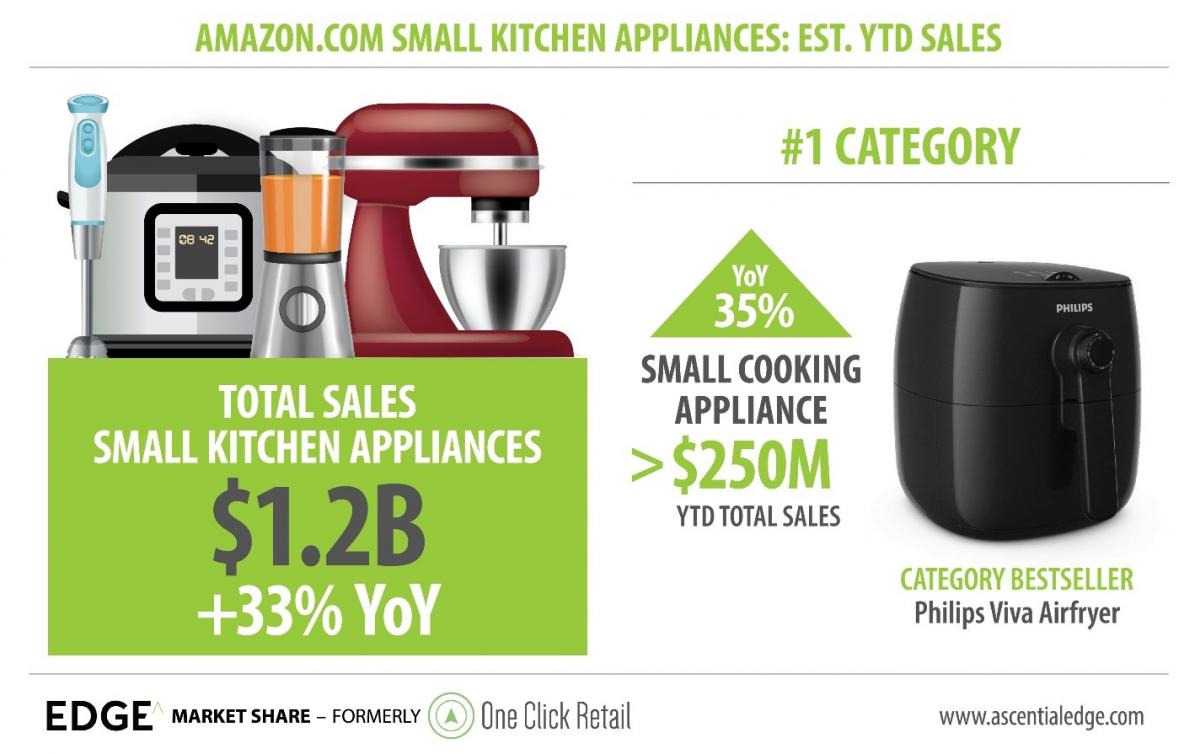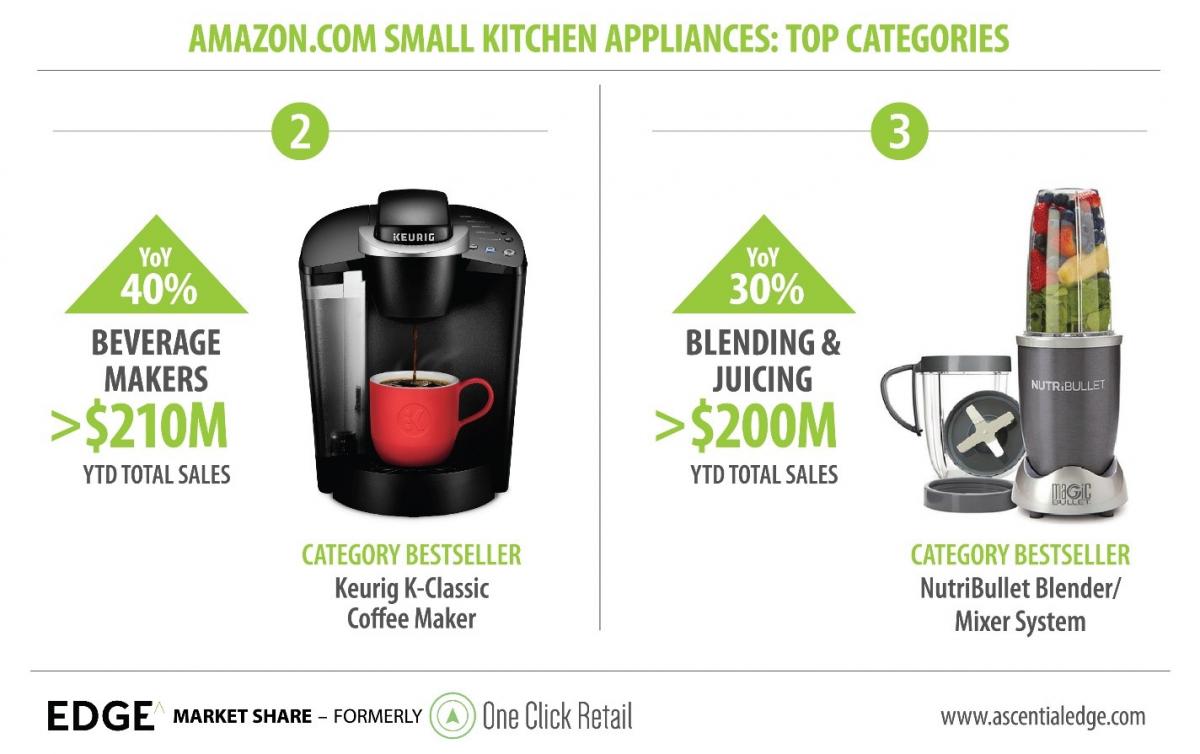The small kitchen appliance market is one of today's most exciting spaces. The huge amount of growth, innovation and consumer engagement taking place in small kitchen appliances makes it the envy of the Home & Kitchen product group. Multiple new reports have concluded that this growth is not going away any time soon. The question is: why? What makes small kitchen appliances so special?
There is no simple answer to that question. Many powerful market forces converge on this one space, from healthy eating and changing consumer lifestyles to innovations in technology and food science. These market drivers reinforce each other, resulting in the exceptional growth we see. But with so much competition, it has become a real battle for the countertop. How can brands gain the advantage?

To identify what makes this a uniquely vibrant space, we've dug into the latest developments and ongoing trends revealed by Amazon's year-to-date sales and year-over-year growth of small kitchen appliances. By carefully analyzing our data, we can glean some insight about how brands are engaging effectively with consumers and what the latest buying habits mean for the continued development of this valuable – and competitive – market.
Key Drivers
- Food Science Innovation
The culinary revolution entered American homes via the Food Network and hundreds of cooking shows, while influential figures such as Michael Pollan have helped to promote a public fascination with food science. At the same time, consumers were educating themselves about the importance of healthy, home-cooked meals. This consumer demand inspired new investments in food science which have brought about several innovative appliances including masticating juicers, air fryers and sous vide cookers.
Masticating juicers are an alternative to traditional juicers and blenders, a result of the discovery that oxygen exposure can deplete the nutrition value of fresh juice more quickly than previously understood. These devices, which are designed to squeeze all the nutrition from the fruit and or vegetables while limiting their exposure to air, grew by nearly 60% to reach an estimated value of $11M. 3P sellers like Doctor Hetznek and Mooka dominate this subcategory with well over $7M in YTD sales.
Air fryers promise the impossible: healthy deep-fried food. It uses convection to achieve the same results as a deep fryer but with only a small fraction of the oil required, leading to much healthier results. Sales in the Air/Deep Fryer subcategory have doubled YoY. Philips and GoWise are the leading brands in the subcategory, but Cuisinart and Black+Decker have strong performers in this space as well.
It's clear that consumers want to have their cake and eat it too – sous vide cookers offer another way to eat 'fried foods' without actually frying them. Sous vide is a method of cooking in which food is placed in a plastic pouch and cooked in a water bath at a precise temperature. This is often marketed as a way to cook a perfect steak without ever using a grill. Though these products are not yet as prominent on Amazon as air fryers, brands like ChefSteps and Anova are having success with their sous vide devices.

- Urban Young Professionals
Brands are engaged in a battle for the countertop. Amazon's customers, mostly urban young professionals, only have so much real estate to fill with small kitchen appliances. This fact is crucial to understanding the category. The most successful appliances do one of two things: they either replace an existing appliance with something more convenient, or they combine multiple functions into one appliance.
Just consider what are by far the two most successful small kitchen appliances in recent memory:
- The Keurig coffee machine (3 of the top 10 small kitchen appliances YTD) replaces traditional coffee makers, offering a much quicker and more convenient cup of coffee for today's on-the-go consumer.
- The Instant Pot (7 of the top 10 small kitchen appliances YTD) combines a pressure cooker, slow cooker, rice cooker, and a number of other functions into a single device.
Urban young professionals are driven by convenience and are working with limited space. To earn their spot, brands need to convince consumers that they will make very good use of that space. The air fryer is one exception to the above 'replace or combine' rule, but it may be the exception that proves the rule. Breville's successful Smart Oven line of toaster ovens has now introduced 'air fryer' to its growing list of functions which could threaten to render stand-alone models obsolete in the battle for the countertop.
The Amazon Effect(s)
Amazon's influence shouldn't be underestimated. The U.S. is the largest market for small kitchen appliances, with $6.5B revenue according to Statista, and Amazon alone is responsible for nearly 20% of it and counting. The retailer has proven to be a key sales and marketing platform for start-ups entering this space due to its lower barrier to entry compared to traditional kitchen wares and appliance stores - and start-ups have driven most of the growth and innovation in small kitchen appliances. So the realities of selling on Amazon have a real impact on brand success in this market.

- Prime Day
Prime Day is no longer an optional event for brands. Many of the fastest-growing products are doing so on the back of successful Prime Day promotions. For example, traditional juicers (Hand, Countertop and Personal Blenders) grew by about 20% overall but saw a YoY increase in Prime Day sales of over 60%. The leading brands, Ninja Professional and Vitamix, are using Prime Day promotions to bring more visibility and conversion to their products, boosting their rank on Amazon. This creates a lift in sales that has the potential of driving more traffic all the way into the holiday season.
Amazon is a marketing platform. This improved visibility reaches beyond just Amazon, it influences consumer behavior across all of retail, driving brand awareness and customer engagement. Conversely, brands that don't partake in Prime Day, or whose promotions are ineffective, will see a significant drop in their Amazon ranking, to the detriment of their performance both online and off.
- Private Brands
Brands don't just need to compete with each other, they need to be aware of Amazon's growing assortment of private label items. So far, Amazon's forays into the small kitchen appliance space are limited to the beverage space. Beverage Makers grew by nearly 40%, driven mostly by Single Serve Brewers but also by Electric Kettles and Water Boilers. Amazon introduced its own product into the latter category in September 2017, the AmazonBasics Electric Kettle, and has experienced a tenfold increase in sales, earning a position as one of the two leading brands alongside Secura.
The retailer's own products are also benefitting from the success of Keurig with the introduction of Solimo coffee pods. This new private brand joins AmazonFresh, Corner One and 365 Everyday Value to give Amazon a wide assortment of coffee pods that fall under the 'Our Brands' label.
Small kitchen appliances is a vibrant and engaging sector. The innovation in this space is virtually limitless and brand manufacturers have countless opportunities to bring more convenience and functionality to American kitchens. Winning the battle for the countertop means understanding how consumers use their kitchens and discovering new ways to optimize their daily routines – without sacrificing either the taste or the nutritional value of their food. But it also means engaging with consumers, and that starts at Amazon.
We're going to continue our coverage of the battle for the countertop in our next insights piece, in which we will discuss the Kitchen Accessories market, the influence of Amazon, and the best practices for brands. Stay tuned!




